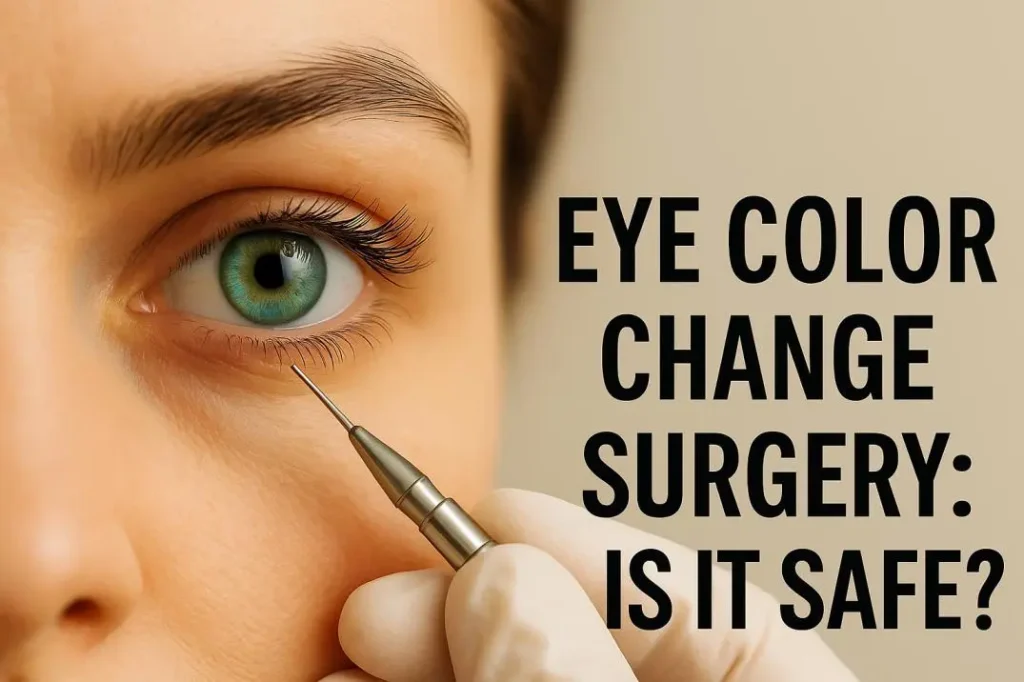Eye Color Change Surgery: Is It Safe?
Our eyes are often described as windows to the soul, and for some, their color plays a major role in self-expression and identity. Eye color change surgery has gained attention as a possible way to permanently alter this unique feature, sparking curiosity and concerns in equal measure.
If you’ve been considering this trend, understanding its safety, effectiveness, and risks is essential to making an informed decision. Here, we’ll break down what these procedures entail, explore whether they’re truly safe, and provide alternatives for achieving your desired look.

AUTHOR
Ophthalmologist/ Eye Surgeon 13+ Years Exp
MBBS, MS – Ophthalmology
TSMC- TSMC/FMR/05251 (2018)
CONDITION
CALL US 24/7 FOR ANY HELP
GET IN TOUCH ON
What Is Eye Color Change Surgery?
The desire to change eye color permanently is not new, but recent advances have made it more accessible. Social media often showcases stunning transformations, fueling interest in these procedures. However, many people don’t realize the risks that come with altering such a sensitive part of your body.
While it’s natural to want a new look, it’s crucial to weigh the potential aesthetic benefits against health risks. No cosmetic enhancement is worth compromising your vision or eye health.
Before we explore the risks, it’s important to understand how these surgeries work and the science (or lack thereof) behind them.
Types of Eye Color Change Procedures
1. Iris Implant Surgery
Iris implants were initially developed to address medical conditions like aniridia (a lack of an iris) or traumatic iris damage. The procedure involves placing a silicone implant over your natural iris through a small incision in the cornea. While this implant can alter your eye color, it is not FDA-approved for cosmetic purposes.
Risks Associated With Iris Implants:
- Increased intraocular pressure, which can lead to glaucoma.
- Cataracts caused by inflammation or trauma during surgery.
- Corneal damage that may require future transplants.
- Permanent vision changes or blindness.
2. Keratopigmentation (Corneal Tattooing)
Keratopigmentation works differently by applying pigment directly to the cornea (the clear outer layer of the eye). Tiny incisions are made to insert the dye, creating the appearance of a new eye color. Advocates claim this method is less invasive than implants, but complications can still arise.
Risks of Corneal Tattooing Include:
- Corneal scarring leading to blurry vision.
- Light sensitivity.
- Potential allergic reactions to the pigment, which can cause painful inflammation or uveitis.
3. Laser Pigmentation Removal
This procedure uses a laser to diminish the melanin (pigment) in brown eyes, revealing a lighter shade, such as blue or light gray. Results are permanent and irreversible. However, this method lacks FDA approval, and its long-term safety remains unproven.
Key Concerns With Laser Pigmentation Removal:
- The laser can release particles of pigment into the eye, blocking drainage channels and increasing pressure, which leads to glaucoma.
- Outcomes can vary greatly, with patients sometimes reporting patchy or uneven color changes.
- This procedure is not safe for individuals with certain pre-existing eye conditions.
Risks and Complications
Eye color change surgeries, by their nature, interfere with the delicate anatomy of the eye. Given the potential for irreversible complications, many medical organizations advise against these procedures for purely cosmetic reasons. Some of the most significant risks include:
- Vision Loss: Temporary or permanent changes in sight due to damage to critical eye structures.
- Glaucoma: Increased pressure inside the eye that, if untreated, can lead to blindness.
- Corneal Swelling and Scarring: These complications can cause chronic blurriness and pain.
- Light Sensitivity: Some patients experience debilitating discomfort in bright settings post-surgery.
5.Post-Surgical Interventions: Many individuals end up needing additional surgeries to correct complications, such as removing implants or repairing injured corneal tissue.
Are There Safer Alternatives?
If you want to enhance or change your eye color without taking on these risks, there are safe and reversible solutions:
1.Colored Contact Lenses
Prescription-colored lenses are the safest and most effective way to change your eye color. Whether you want a subtle enhancement or a bold transformation, many options exist to suit your style.
Benefits of Contact Lenses:
- Completely reversible.
- Available in a range of colors and finishes.
- Prescribed and fitted by licensed optometrists to ensure proper safety.
2.Professional Eyewear Consultation
Eye care specialists can assist in selecting the most appropriate colored contacts while ensuring they’re FDA-approved and suited to your eye health.
FAQs About Eye Color Change Surgery
- Are these surgeries FDA-approved?
No. None of the procedures discussed (iris implants, keratopigmentation, and laser pigmentation removal) are FDA-approved for cosmetic purposes. - What are the long-term effects?
Long-term risks could include vision deterioration, uncontrolled eye pressure requiring lifelong medication, and recurring infections from complications. - Who should avoid these procedures?
Anyone with pre-existing eye conditions like glaucoma, dry eyes, or keratoconus should avoid any surgery targeting their eyes. Consulting an ophthalmologist is crucial before pursuing any option. - How do I find credible colored contact lenses?
Always purchase contact lenses through reputable optometrists or eye care providers. Avoid online retailers offering non-prescription lenses.
Final Thoughts
Your eyes are invaluable, and no cosmetic upgrade is worth endangering them. While the allure of changing your eye color forever may seem exciting, the surgical risks far outweigh the benefits. It’s crucial to rely on science-backed, medically approved methods whenever altering your appearance, especially when it involves something as delicate as your vision.
Your Next Steps
If you’re considering a change in your appearance, talk to a qualified ophthalmologist or optometrist first. They can recommend ways to safely explore your options without risking complications.
Remember, preserving your eye health is always the top priority. For more information, schedule a consultation with an eye specialist today. Together, you can find safe and satisfying solutions for your cosmetic goals.
Appointment Form
AUTHOR
Ophthalmologist/ Eye Surgeon 13+ Years Exp
MBBS, MS – Ophthalmology
TSMC- TSMC/FMR/05251 (2018)
CONDITION
CALL US 24/7 FOR ANY HELP
GET IN TOUCH ON
Appointment Form
About Us
Saijyothi Eye Hospital, where excellence meets compassion. Founded by the esteemed Dr. Saibaba Goud, M.S., Ph.D., Padma Shri Awardee, our institution stands as a beacon of hope for those seeking exceptional eye care. Dr. Saibaba Goud’s vision goes beyond restoring sight, aiming to transform lives. At Saijyothi Eye Hospital, we offer exceptional care, from routine eye exams to advanced surgeries, with personalized services tailored to each patient’s needs.
Our Locations:
West Marredpally
- Plot No 185, Road No 1 Beside Kennedy School, Opposite lane to Om Shanthi Foods, West Marredpally, Secunderabad-500026.
Kompally
- 3rd Floor, Vaishnavi Lemini Arcade, Doolapally Road, Above Ratnadeep Super Market, Devender Colony, Kompally, Hyderabad, Telangana 500014
Uppal
- D.No. 2-2-15, Hanuma Sai Nagar, Uppal X Roads, Near Gandhi Statue Centre, Uppal, Hyderabad, Telangana 500039

